But everyone who hears these words of Mine and does not act on them is like a foolish man who built his house on sand.
(Matthew 7:26)
In the mid-19th century, Edward Hincks (1792-1866), an Irish clergyman, came to several paradigm-establishing conclusions while studying the cuneiform tablets that had recently appeared out of Mesopotamia, modern day Iraq along with part of Syria and south-eastern Turkey. The hitherto unknown language dubbed Akkadian could be usefully deciphered thanks to equivalences in Old Persian and other languages. Reverend Hincks, who was a fellow of Trinity College Dublin, took the process a step further, establishing that the individual symbols could be matched to different sounds and meanings according to the context in which they were found. In the process, he worked out that the Akkadian language derived from – but was not otherwise intimately related to – another earlier language also found on clay tablets and in the same region of the world. Sumerian, despite providing the written forms and the sounds serving to create the writing system of Akkadian, was, according to Reverend Hincks, an isolated language. It was also the finding of the clergyman that Sumerian was an agglutinative language, i.e. comprising words made up of several different signs/syllables used together, a multi-syllabic language. Tablets discovered among the ruins of Nineveh, modern day Mosul in Iraq, contained long lists which he took to be bilingual dictionaries, showing Akkadian words in one column and the more ancient Sumerian language in another. Thanks to this evidence presented to academia by the Reverend Hincks, a founding paradigm was firmly set in place and the rules of grammar according to which all Sumerian has since been translated were established.
My own understanding of those precious tablets known today as the lexical lists is that they were not bilingual dictionaries but relatively complex etymologies. Providing the origins of the form and sound of later words, the lists also gave explanations of the ultimate, the oldest meanings. It might be said that Sumerian was to Akkadian what Old English is to the (largely artificially) evolving English of 2021…more or less. Not isolated at all but the most ancient of mother tongues. And it is my contention that the method of study and translation of the earliest of all literary texts as initiated by Reverend Hincks, however ground-breaking his work overall, has led to the linguistic equivalent of building a house on sand…
Who’s Who?
One of the greatest difficulties in translating the Sumerian texts lies in understanding who is who. Well, that’s my opinion anyway. Past generations of scholars don’t appear to have had the same problem. Take the oldest known story dubbed The Instructions of Shuruppak (ETCSL, Electronic Text Corpus of Sumerian Literature ref.5.6.1). This is not the first time I mention the obvious discrepancies which led me to undertake its re-translation, but I will mention them again for those who haven’t been following. According to the academic version, Shuruppak is the wise father giving weird advice to his son whose name is Ziudsudra. Ubara-Tutu is named as the father of Shuruppak. That simple family tree – grandfather, father, son – is introduced in the first few lines and cheerfully repeated several times along the 280-line text, an overt signal that the text includes a refrain and is therefore most likely to be a long poem or a play of some kind. My own version relies on a different method of translation, considering that those three names are, in fact, comprised in all of ten or eleven short and distinct words, all of which must be taken into account – individually and collectively – within an established context. The resulting translation is very different. Ubara-Tutu was left standing alone at the end of that purge.
There are several ways in which to show and, dare I say, to prove that Shuruppak is not and never was a wise man. Neither was he a fool. Nor did he have a father called Ubara-Tutu. Put simply, the name is invariably followed by the word KI, understood to be a suffix indicating a place name. SU-KUR-RU-KI (Sukuru/Shuruppak) appears four times in The Instructions of Shuruppak. It also appears in exactly the same configuration in the antediluvian section of the Sumerian King List (ETCSL ref.2.1.1) where it’s meant to be understood as a place name. That is what the academic version tells us. Named twice, on lines 31 and 32, Sukurru/Shuruppak is the city ruled by a guy called Ubara-Tutu immediately before the advent of a flood:
and the kingship was taken to Šuruppag. In Šuruppag, Ubara-Tutu became king; he ruled for 18600 years.
Enter The Fool
In The Story of Sukurru (aka The Instructions of Shuruppak) and in the context of the preparation of a waterproofed vessel, a new character is introduced into that age-old pre-flood account. But then again, this might equally be a new epithet for a figure having already made their appearance under a different name, perhaps even NO-A who pops in on line 98. Perhaps not. Nothing can be ruled out unless by cross referencing and some reliance on logic.
My own folly at the time of translating lines 111 (here above) and 112 was to replace a pictogram with another unmentioned pictogram. I took the liberty of replacing the pictographic form of LIL with that of LIL₂ and did it twice. On reflection, I regret not having left the space empty. The problem was that the real LIL, the old fool, had got lost. I could find no trace of it nor anything that might have allowed me to copy something of its original form. And so what you see above is not LIL. It is LIL₂, otherwise known as KID.
KID also has the given meaning ‘fool’, which is why I chose to use it in place of LIL. They are related. Seen here on the right, this version of the evasive and thus ghostly LIL is borrowed from a computer-generated form on the ePSD (electronic Pennsylvania Sumerian Dictionary) website. In fact, LIL appears very few times in the longer Sumerian texts, just twice in Enki and Ninmah (ETCSL ref.1.1.2), twice in The Instructions of Shuruppak, and relatively few times overall before 2500 BC.
Why is this substitution of a pictogram on two lines of The Story of Sukurru regrettable? At the level of translation, it isn’t. The meaning of ‘fool’ was correct. But overall, I refrained from any form of twisting or glossing over which might serve to undermine the value of the work. Genuine mistakes are more forgivable in my view; the wrong symbol transcribed or a word added that was not in the original script. There have been a couple of minor mistakes made in The Story of Sukurru. I tend not to forgive myself but hope that others will.
The potential importance of lost symbol LIL came to my notice only recently while finalising Lost Stones of the Anunnaki, which will include a re-translation of the antediluvian portion of the Sumerian King List. The intention is to demonstrate the value of a monosyllabic method of translation, bringing back into play the large number of words on that immensely important historical document which had been ignored and left untranslated by previous translators – all followers of Reverend Hincks’ doctrine.
Of Kings and Their Folly
Probably the best-known example of the King List is the magnificent prism (see photo) held within the walls of the Ashmolean Museum, founded in 1683 and part of the University of Oxford. That imposing rectangular tablet is dated to the Old Babylonian period ca.1900-1600 BC. Its details, including a copy of the original transcript, are recorded under reference P384786 on the CDLI (Cuneiform Digital Library Initiative) website.
There are three steps in the journey between words inscribed on clay tablets by Mesopotamian scribes and their presentation to the world in English or any modern language. The first is particularly difficult in that the specialist must use a magnifying glass to read and to transcribe on to paper the tiny abstract cuneiform signs inscribed on the tablet. By the Old Babylonian period there was nothing left of the rounded pictograms from which the words had evolved and so it’s easy to imagine that the task of transcribing that huge prism was long-winded and difficult. Damage to certain portions no doubt made the delicate job more difficult still.
The second step is to take the pictographic or cuneiform signs copied on paper and to label them with their alphabetic equivalents, termed the transliteration. When that process is complete, the alphabetic forms, phonetic values of the original symbols, serve as the basis for translation. For example:
The transliterations of many Sumerian tablets, including those of The Instructions of Shuruppak and the King List, are presented on the excellent Electronic Text Corpus of Sumerian Literature (ETCSL) website, also provided by the University of Oxford. No doubt those that we have in hand, corresponding to most but not all of the important texts of the Sumerian corpus, were compiled from transcripts made by previous generations of squinting scholars working at the university or elsewhere, in other prestigious centres of learning or museums. These days and with the transcripts already in hand, it’s likely and, I suggest, normal that no-one bothers to go right back to consult the original tablets for information. We assume that the copies are correct. We further assume that the transcribed Sumerian words correspond to their given sounds. From tablet to transcript to transliteration to translation, in these three steps we trust.
Nevertheless, I had already encountered both Shuruppak and Ubara-Tutu before and was curious to see them through the eyes of the master scribe who had noted them on the prestigious Ashmolean prism some four thousand years ago. Clearly, no-one was going to give me the key to its glass shelter inside the museum and then lend me a magnifying glass. But, again entirely thanks to the University of Oxford, I was able to do the next best thing which was to look at the original transcript on the CDLI website and to compare it to the transliteration of those 39 lines of the antediluvian King List. I went looking for Ubara-Tutu. But found only his feet…
Man Overboard
The final ruler before the flood, not yet disappearing under the waves, should have been made up of three Sumerian words: UBARA DU DU. Symbol DU takes the form of a foot, and has given meanings which include ‘establish’, ‘stand’ and ‘carry’ among others. The double symbol, if understood in the context of a man and sailing vessel, gives ‘sailor’: Ubara the Sailor.
DU DU should be found on the transcript as two feet and that is indeed what we see on line 32, shown here on the left as a pictogram and borrowed on the right from the Ashmolean transcript (the writing has been added):
UBARA is a more complex word where one symbol is enclosed inside another, in this case KASKAL inside EZEN. EZEN is linked to ‘festival’ and to ‘song’ while KASKAL brings the ‘beer’ and is also read as ‘crossroads’. In all, a strange combination for the name of a king. We might be forgiven for understanding from it that he liked to party with passers-by. The word and its elements would once have looked something like this:
But that isn’t what is copied on line 32 of the transcript. This is how Ubara-Tutu appears directly after the name of the city of Sukurru/Shuruppak:
The line number, transliteration and question mark have been added for clarity. Whatever the word to the left of Dudu/Tutu, it is not Sumerian UBAR/UBARA. Neither is it the name said to have been given to the final ruler by the much later Greek author, Berossus. Unless I am grossly mistaken, it represents a completely new piece to an age-old puzzle. I went looking in every corner of the known Sumerian world for the identity of this sign which, if the dotting on its transcribed form is taken into account, appears to have been damaged. There were just two words that more or less fit the bill: one is SUHUR, the carp, and the other is LIL, the fool:
So the question must be asked. What was the name of the ruler at the time of a flood according to the four-thousand-year-old Ashmolean prism? A fool who was a sailor? Foolish because he sailed or because he waterproofed the vessel from the outside and was left behind? A fool who was also a fish? A fool of God?
My aim is not to belittle the work of those who, over the past couple of centuries, have provided and continue to provide all the necessary tools to prise out the secrets of this language. My only ambition is to know the truth about the Sumerians and to learn it directly from those scribes who also worked so hard to write the information down in the first place. Perhaps the transcript of the Ashmolean prism wasn’t used to provide the ETCSL transliteration, but then why not go public with this newly discovered name? Surely it would spark debate among Assyriologists and other historians. Would it not be of historical interest?
I wait to be corrected on the apparent error made at some point in time between transcript and transliteration of the antediluvian king’s name in this particular case. If it happens, I will of course accept to be proven wrong and move on. If not and a mistake has indeed been made, I will be happy to have helped set the record straight. Mistakes are human and a pot should always be wary of calling a kettle black. But I must insist on a more fundamental error. This is not an isolated language and, if not a tsunami, then a multitude of gently lapping waves must slowly but surely undermine the flimsy foundations on which our understanding of the Sumerian language has so far been based. Only a fool would expect a house built on sand to stand eternal.






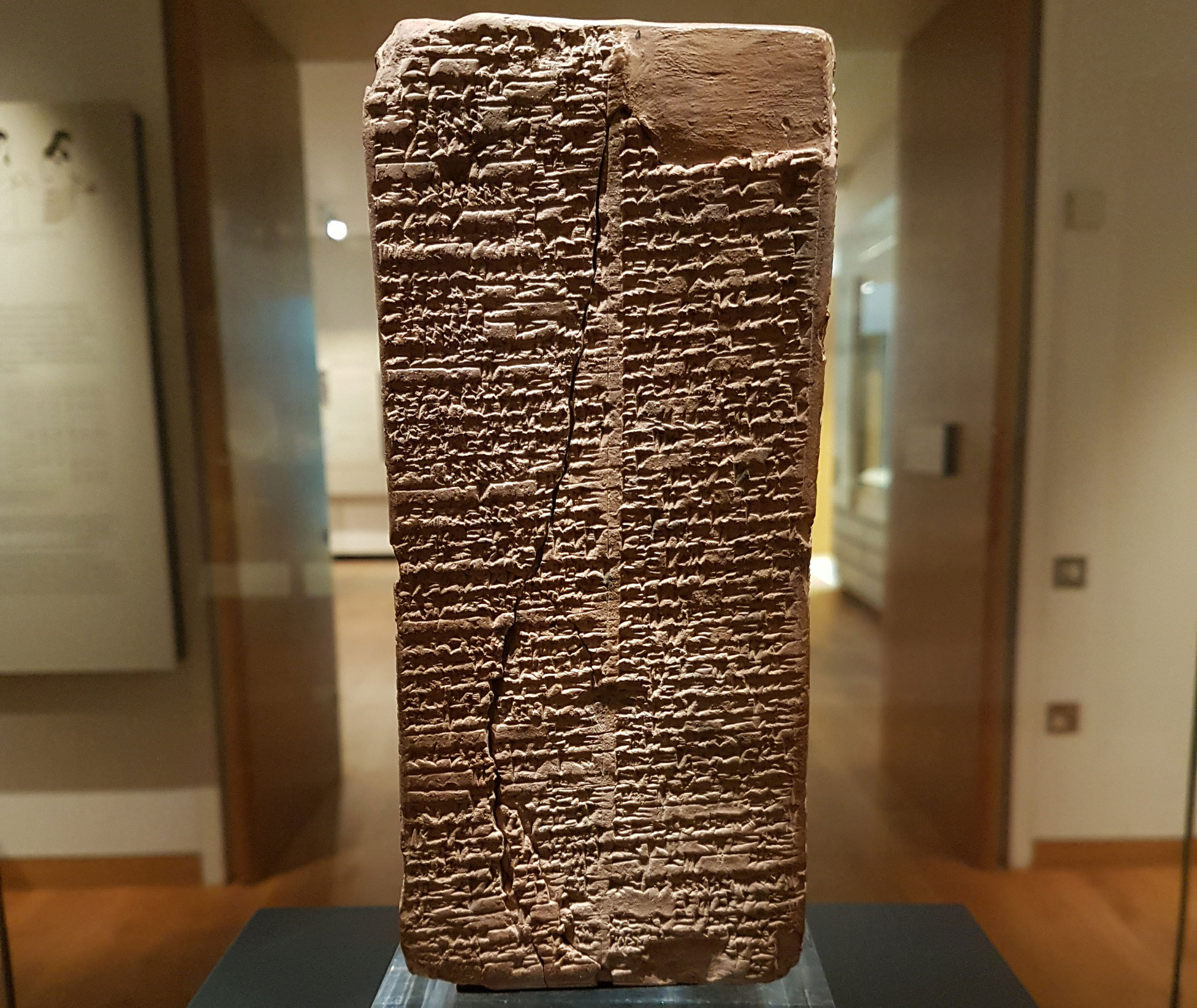


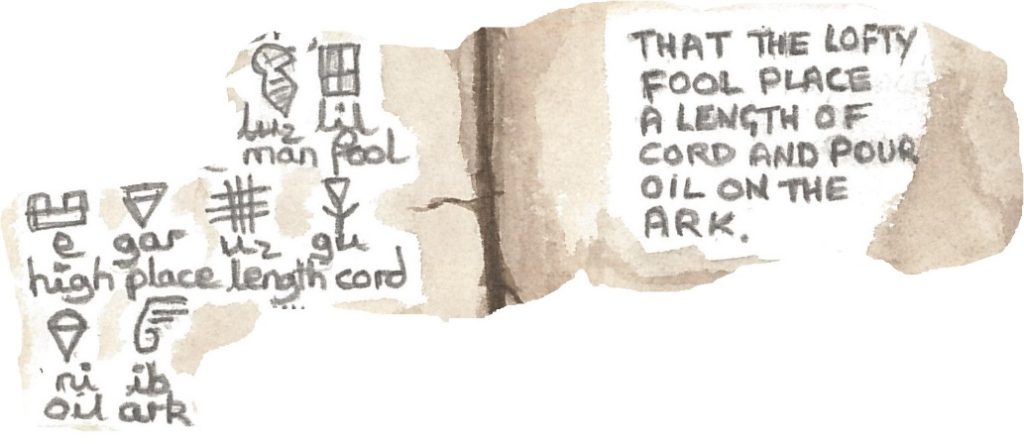
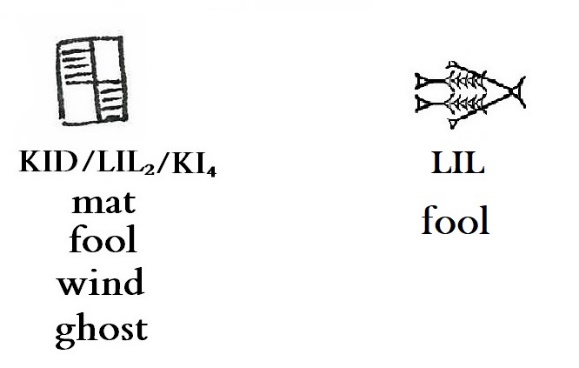

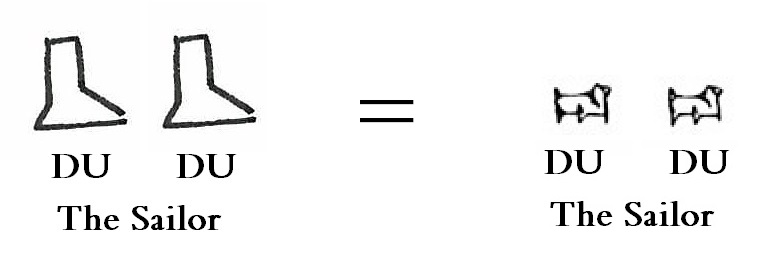
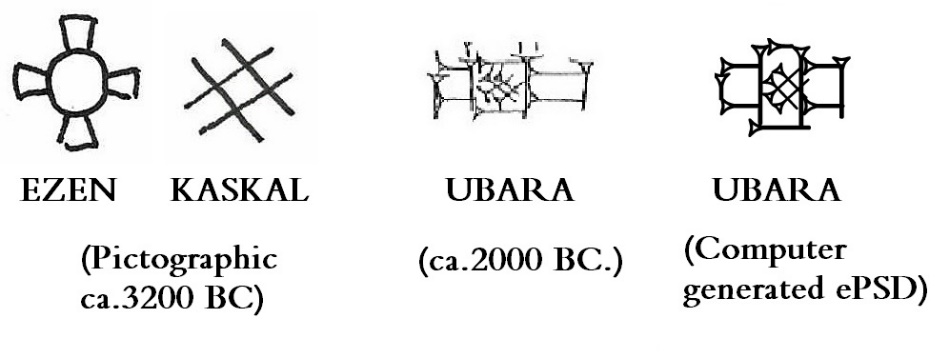

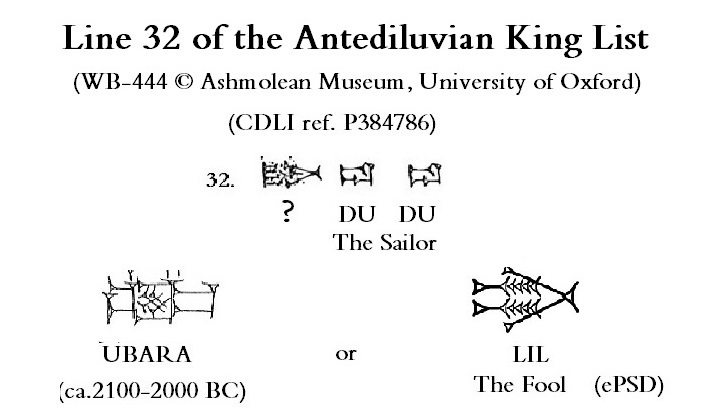
The phrase ‘Man Fool high place length cord oil ark’ reminds me of the temple-building rituals of Ur Nanshe of Laghash. He built sixteen shrines, eight statues, followed inspiration, did not understand the building plan, enlisted allies and contractors from all over the region, surveyed eight rooms, erected eight doors, built eight frames, set up six slabs in the middle, surveyed by An, Enlil and Enki (perhaps three equators or grids), and appointed a long list of ministers and priests, each with a portfolio.
Could this phrase perhaps say ‘He, the Measurer /Maker /Builder /Navigator /Surveyor /Imitator /Re-creator, at a sacred place, measured and sanctified /visited a shrine’? Thus a similar formula applied to kings, priests and patriarchs, in their building and rituals, of temples and boat arks and portable covenants? Thus poetic language uses apparently concrete words, but their meanings are poetically diverse?
Could puns have applied at the level of visual shapes, and homophones, and phrases, and symbols, and calendar? But as mere conventions or scribal conventions not intended to be part of the meaning?
Could it be that some of these meanings were ‘real’ or mutually verbalised by scribes and clients, and some of these meaning were semi-real or symbolic, and some features of the signs or syllables were ‘unreal’ or not intended?
Could Sumerian signs or syllables have also been alpha-numeric?
Could cuneiform writing have been much more different from the spoken language, than alphabetic writing systems are? Thus, was writing a different medium, that could not be studied as a grammar? Thue presenting difficulties to translators?
Should translators consider every image and every syllable as meaningful, or are some just incidental to the written system?
Was the Flood referred to here, an annual event?
I have demonstrated layers of formerly invisible archetypal structure in an academic translation of Ur Nanshe’s rituals (Iraq Nat Mus CDLI P222390, Furter 2016 Stoneprint p177-191), similar to all myths of all cultures and ages. Religious legalism is universal and eternal. Could your take Frazer’s lead in interpreting fragments from one culture, by fuller context from another? Such as Egyptian, Indian, or Greek?
Could you identify which legend in the ATU catalogue applies to the theme of the prism bearing this extract?
Edmond writes: Could this phrase perhaps say ‘He, the Measurer /Maker /Builder /Navigator /Surveyor /Imitator /Re-creator, at a sacred place, measured and sanctified /visited a shrine’? Thus a similar formula applied to kings, priests and patriarchs, in their building and rituals, of temples and boat arks and portable covenants? Thus poetic language uses apparently concrete words, but their meanings are poetically diverse?
Hello again, Edmond,
No, the preceding 110 lines of translated text do not indicate that the above is an acceptable sentence with which to follow them, particularly as none of the words you propose appear in it. The subject here is translating, a process which involves using, for the most part, known given meanings for each word, and considering them according to the overall context. Flights of fancy are not an option unless perceived – with good reason – as being those of the original scribe. Otherwise, the work becomes nothing more than personal interpretation and embroidery and loses all its value. And it’s always a good idea to avoid verbosity.
Madeleine
Madeleine, why do your translations differ from the academic translations?
Hello Madeleine
Excellent work. I admire your tenacity in recovering an ancient culture into a modern context.
I so look forward to your conclusions writ out for academics to refer to.
drew
Thank you, Drew. And I look forward to the conclusions of the University of Oxford. After all, they are the custodians of the artefact and as such must take an interest in the integrity of the information provided to other Assyriologists, historians and/or to the general public. This subject being not a matter of opinion but one of fact, of right or wrong, it will be interesting to have their thoughts.
Madeleine
43 When the unclean spirit is gone out of a man, he walketh through dry places, seeking rest, and findeth none. 44 Then he saith, I will return into my house from whence I came out; and when he is come, he findeth it empty, swept, and garnished. 45 Then goeth he, and taketh with himself seven other spirits more wicked than himself, and they enter in and dwell there: and the last state of that man is worse than the first. Even so shall it be also unto this wicked generation.
42 The Queen of the South will rise at the judgment with this generation and condemn it; for she came from the ends of the earth to hear the wisdom of Solomon, and now One greater than Solomon is here. (Matthew 12)
https://grahamhancock.com/phorum/read.php?8,1225004,1225004#msg-1225004
Thank you for reminding me. This is not the only riddle embedded in The Story Of Sukurru/The Instructions of Shuruppak, but it is potentially the most earth-shattering…
Madeleine
Sumerology / Assyriology isn’t my area of expertise, but I can manage my way through electronic dictionaries just fine.
What if LIL (?) here is actually intended to be read as KUR (?) also written KUR₉/KU₄(?), KURˣ(DU)/KUˣ(DU)(?), which means “to enter, to make enter, bring in, introduce, to become, turn into, be declared to be, to be made liable for”. How would that change your understanding of the word LIL.DU.DU to KUR.DU.DU.
In Akkadian this same cuneiform is read as erēbu, which immediately brings to my mind the Greek primordial entity Erebus (Ἔρεβος) usually translated as “Darkness”, one of the offspring of Chaos (χάος) “emptiness, vast void, abyss”.
Since we are discussing Antediluvian figures, this seems like an appropriate comparison to make.
Erēbu (?) + UŠ (?) would give us “to become” + “to die”, from Akkadian mâtu (?)/mūtu (?) meaning “to die”.
So, in that sense LIL.DU.DU (??) could be something like “ferryman (of) death”, “bringer of the dead” or “death bringer”. At any rate, it sounds like some kind of harbinger, messenger, psychopomp, or in the more active sense “Destroyer”.
Also, regarding UBARA.TU.TU… You addressed BARA2 (?).
There are several other words that seem to lend additional context to the transliteration of the Shuruppak story.
1st: UBAR (??) which means “foreign”, “foreigner”, “resident alien”. This is interesting in and of itself since it decomposes into the following roots:
U (?) “water; edge, rim; totality, world; secret, shelter; protection, aegis, shadow, shelter; to sink down; to cloud over; to cover, to spread over; to envelop, overwhelm; covering; surface; to raise (clothes)”
BAR (?) “outside, (other) side; behind; outer form, outer; fleece; outsider, strange; back, shoulder; liver; because of; to set aside; to cut open, slit, split”
BAR (?) can also be written as BA.RA (??), from:
BA/BAR (?, as above) and…
RA/RAH₂ (?) “to beat, kill; to break, crush; to flood; to thresh (grain with a flail)”, probably implying “to drive out”…
Possible implications:
“driven from the outside world”
“driven out of shelter”
”
I can’t help but notice what appears to be a cognate with the Semitic word BAR. In Hebrew, for example BAR (בר) means “son, outside, open field, prairie, OCEAN”
The “ocean” reading of BAR (בר) really underscores the idea of U.BAR (??) as relating to “overseas”, “from (the) sea”, in relation to the idea of being “foreign”. It seems that to the Sumerians, for whom a water god played a prominent role in the “creation” of mankind, this idea of “foreign”-ness was deeply informed by the idea of water as a barrier, and one that perhaps only a god might be able to traverse, i.e. the Apsu / Abyss of legend.
Tack on to that TU.TU.KE4 (???) / DU.DU.KE4 (???) for a worker class (DUDU / TUTU (??, “go” + “bring”) of some kind, plus KE4 (?) for “open country, wind, secret knowledge” and I think there is a strong case for some kind of sailor/knowledge keeper in this epithet:
“curuppagki dumu ubara-tu-tu-ke4”
“Shuruppak, child (of a) foreigner land, go, bring (from) open country”
“Shuruppak, child (of a) foreigner land, go, bring (upon) wind”
“Shuruppak, child (of a) foreigner land, go, bring (upon) secret knowledge”
Again, not my field of expertise. I could be wrong.